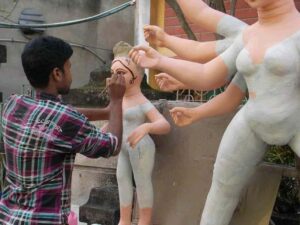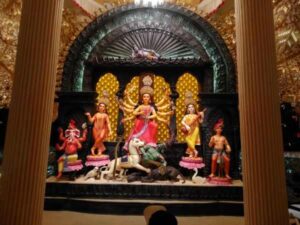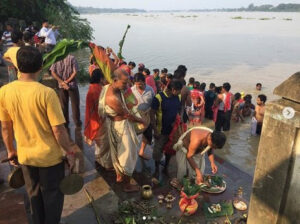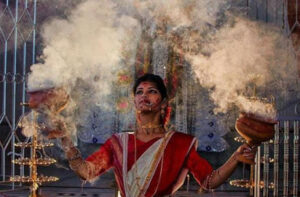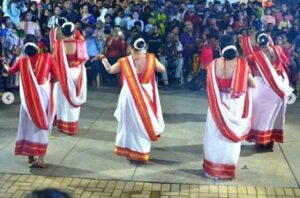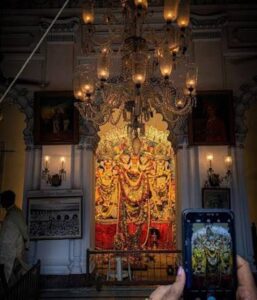Durga Puja is the biggest festival for Bengalis and celebrated with great pomp in the eastern part of India. Hindus observe two Navratris during a year. The scriptures suggest that the Navaratra that falls on the month of March-April(Hindu calendar month Chaitra) during spring is the actual time to evoke the Goddess. Lord Ram had invoked the Goddess in the month of Ashvin by performing her puja six months before the time of her worship. This untimely awakening of Maa Durga is called Akal Bodhan.
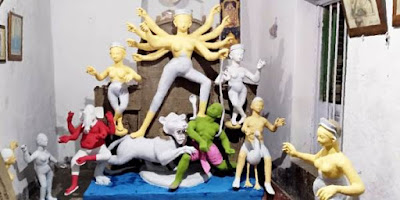 |
| Goddess Durga in the making |
As per the mythology, to get miraculous powers, Ravan, the king of Lanka, had performed an intense penance for several years. To get God’s attention, he chopped off nine of his heads as offerings.
Just as he was about to sacrifice his tenth and last head, Lord Brahma appeared and blessed him with a boon that no god, demon, animal, or bird could ever kill him. Ravan did not seek the boon for protection from human beings.
During one of his conquests, Ravan came across Mount Kailash, the abode of Lord Shiva and Goddess Durga. Unable to proceed further with his Pushpak Vimana (a flying chariot) over the mountain, an enraged Ravana decided to uproot the mountain out of his way.
Annoyed by Ravan’s arrogance and pride, Lord Shiva pressed his left toe gently on the ground of the mountain. Soon, Ravan was pinned under the load of Kailash, crying in agony and pain.
Ravan realized his mistake and sang hymns in praise of Lord Shiva for a thousand years.
At last, Lord Shiva forgave Ravan and released him from under the weight of Kailash. Pleased with his devotion, Shiva even awarded him with the Chandrahas (a crescent moon-shaped sword).
Goddess Durga also granted him a boon that no enemy of his would be able to defeat him without her permission.
Also Read: Dhunuchi Dance – Keeping The Tradition Alive
The story is found in the Krttivasa’a Ramayana that Ravan had abducted the prince of Ayodhya, Lord Ram’s wife, Sita. Lord Ram led an army of Vanars (monkeys) to wedge war against the demon king Ravan.
In the war field, Ravan was slain into two halves by Ram. But the boon from Lord Brahma revived Ravan. He worshipped Goddess Durga to support him in his battle against Ram. Goddess joined him and sat with him in his chariot.
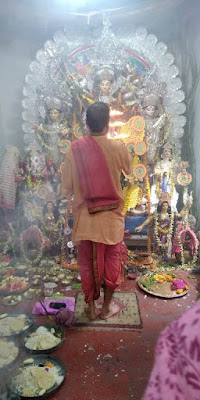 |
| Maa Durga Aarti |
Disheartened by the defeat, Ram decided to invoke Goddess Durga to defeat Ravan. Lord Ram needed 108 blue lotuses to complete the puja and seek her blessings. To test Ram’s devotion, Goddess Durga stole one of the lotuses, leaving him with only 107 blue lotuses.
It is then that Ram – whose eyes were blue and supposedly like a lotus (he was known as Padma-lochan, literally meaning eye like a lotus) decided to offer his own to the Goddess as a substitute. Pleased by the willingness of her devotee to make such a great sacrifice, Goddess appeared and granted him the power to kill the demon king.
It is commonly believed that the Gods and Goddesses sleep for six months and stay awake for another six months. Ram’s invocation was untimely (Akal) since the Goddess was thought to be asleep in the autumn and generally worshipped in the spring.
Thus, Sharadiya Navaratra is called Akal Bodhan, the untimely invocation.
Brahmin priests perform Durga Puja. Some variants of the mythology suggest that Ram, a Kshatriya prince, had asked the brahmin Ravan to perform the puja. Ravan, being a brahmin, could not turn down the request. So, he served as the priest for the Ram’s Durga Puja, which led to his demise.
Ram had started his worship of Goddess Durga on the sixth day of Ashwin’s Shukla-paksha after the Amabashya (Mahalaya). That day is known as Sashthi. This day marks the beginning of Durga Puja for Bengalis.
Also Read: Sindoor Khela – The Most Colorful Ritual Of Durga Puja
